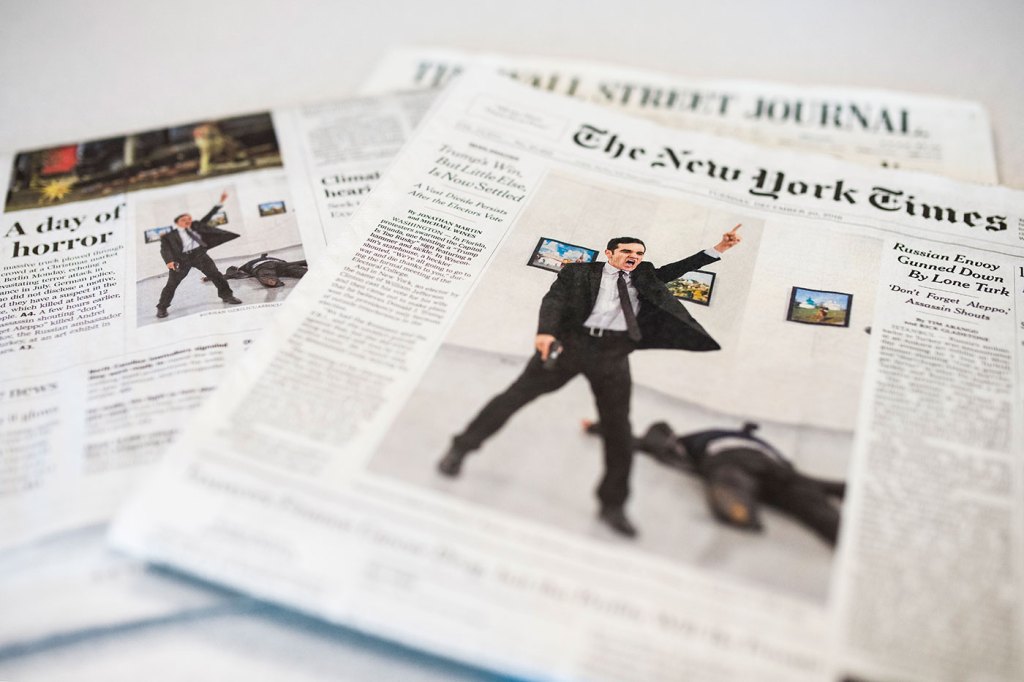3Qs: Breaking news, graphic images, and where to ‘draw the line’

The assassination of Russia’s ambassador to Turkey at an art exhibit in Istanbul on Monday was caught on camera—both video and photo—by photojournalists covering the event. The striking images, which show a gunman in a suit and tie standing beside the body of envoy Andrey G. Karlov, ran across newspaper front pages internationally the next day, including at home in The New York Times and The Washington Post.
We spoke with Matthew Carroll—professor of the practice in Northeastern’s School of Journalism and a former Boston Globe reporter on the newspaper’s Pulitzer Prize-winning Spotlight team—about the intense situations in which journalists sometimes find themselves as well as what goes into the decision to run a controversial photo.
From your perspective as a journalist, what are the sorts of decisions, emotions, and judgment calls you must grapple with when you’re suddenly thrown into dangerous, breaking news situations?
First of all—and I don’t think any head photographer would disagree with me on this—the photographer has to keep himself safe when a dangerous situation comes up. I don’t know what Associated Press photojournalist Burhan Olzilici (whose photos ran in both The New York Times and The Washington Post) was thinking at that very moment, but he stuck in there. He got some tremendous pictures as a result, but no one would have blamed him if he had run from an active shooting scene.
I’m sure it was terrifying. You have this situation where it’s a story from an art gallery event, and as a photographer you’re probably bored out of your mind, thinking you’ll get a photo for the back page or maybe the arts page. Then, all of a sudden, chaos erupts and this goes from a garden variety picture to incredibly dramatic, worldwide front page news. The adrenaline starts running, and you hit that fight or flight response. You’re either going to keep shooting photos or you’re going to run. In this case, he decided to keep shooting.
I’ve never been in a frontline battle situation myself, but I have been in neighborhoods where there are people milling around and it’s a hot scene—a murder scene, for example.
You think: “Is it worthwhile pushing through this crowd right now? Or should I wait a little while?” I’ve done it both ways; it’s a gut feeling. If I feel nervous and my photographer feels nervous, then we leave. There’s no sense getting beat up or worse over a story.
Is there an emotional toll that working on these types of stories or capturing these types of photos takes on a journalist? How do you balance this work with a home life?
It does bother you. When we did the Spotlight stories about the investigation of sexual abuse in the Catholic Church, a series about which a movie was eventually made, we were on that for more than a year. I interviewed these guys who had been horribly abused and I got really burnt out from those conversations.
I remember realizing that—and it was the first time I had a lot of empathy for social workers—people do this type of work day in and day out, all the time.
I remember being told by a friend, who’s a nurse, that all the members of the team had probably experienced some level of post-traumatic stress disorder from these stories. It’s mentally very tough, and we’re also working tremendous hours for months and months. It’s very stressful.
The New York Times’ public editor has addressed reader concerns about the decision to put Olzilici’s photo—taken moments after the assassination—on the front page. In your experience, what are some of the factors journalists and their editors consider when deciding where and how prominently to run potentially graphic images?
From what I’ve seen, the photos they’ve run are not all that graphic, in terms of what you can and can’t see. That’s a key consideration: how graphic are the pictures, and where’s the line we draw so we don’t have people crying over their morning oatmeal? It’s a total gut call, and every news organization has to draw that line for themselves.
The other thing to think about is, how important is the issue? How close to that line do we want to get? It’s very hard, and there’s no wrong or right answer; a lot of people handle it very differently. For instance, the European papers probably played it differently than the American papers.
And what you’re seeing, over the past decade especially, is that the pictures getting published are much more graphic. Because of the internet, people are more used to seeing graphic images. You think of the photo of a Syrian refugee toddler on the beach—unfortunately, people are more and more accustomed to seeing dead bodies.
I would convene the chief photographer, the photographer who took the picture, and the news editors in a room and display all the pictures from the event. Then they would all have to decide, “Where is the line we’re going to draw? Which are the photos we’re going to run that tell the story without unduly upsetting our readers?” You start looking at what’s the best, and find where you draw the line, together.





